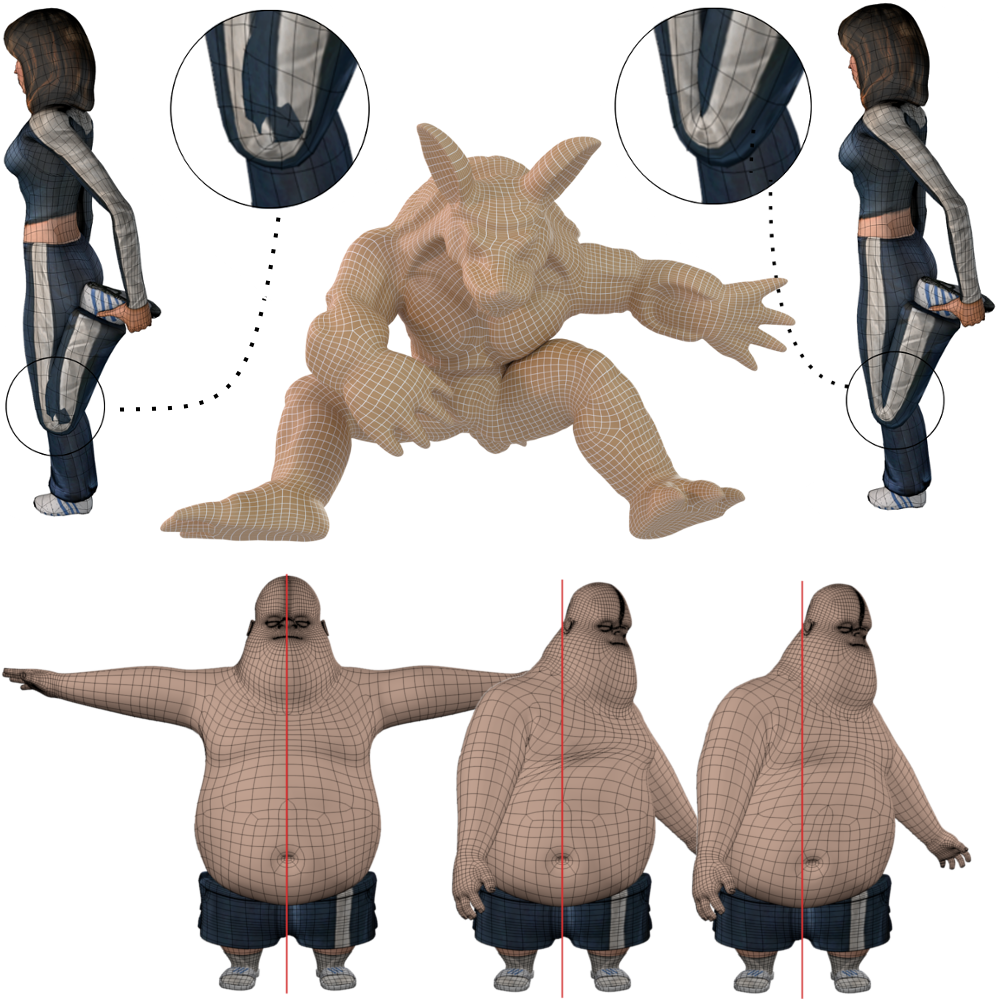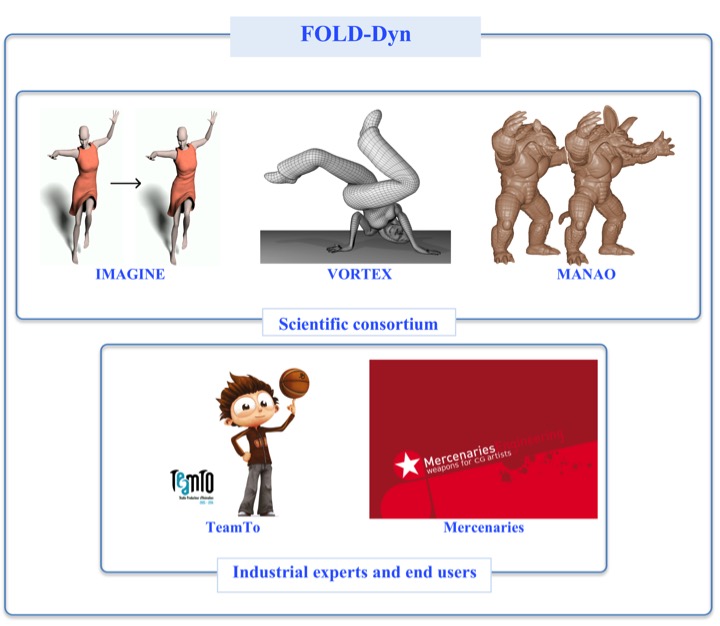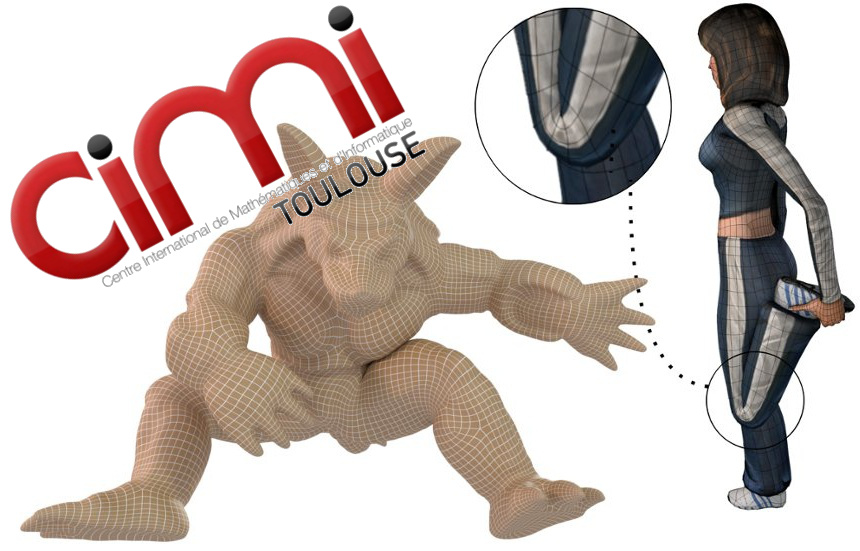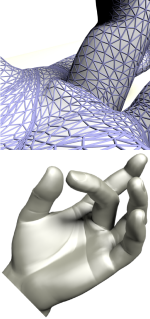Implicit Skinning: skinning animated characters with contact

|
General project
Started in June 2011
On going
Presentation
The implicit skinning project studies and develop interactive skinning solutions for computing digital character animation deformations. It relies on the conjoint use of 3D field functions and 2D meshes in order to take the best of each representation: composition operators, collision detection, contact handling for the field functions, and standard representation, efficient geometry processing for meshes.
This general project has already been funded by the ANR (IM&M and Fold-Dyn), the CIMI Labex (DEMAGOs-3D), fundings managed by Brian Wyvill (University of Victoria), the SAT Toulouse Tech Transfer, the ERC grant Expressive (Marie-Paule Cani) and the University of Toulouse.
Private companies have also been involved in a way or another in this project: The Foundry, Mercenaries Engineering, Team To, Caleido-scop.
|
top
Comprehensive Analysis of Light Transport Operators for image synthesis (CALiTrOp)

|
ANR : National Research Agency - Projets de recherche collaborative.
Accepted in December 2016
Ending January 2022
Presentation
The main questions concern the identification and the understanding of the global structure of the light-paths space, that is driven by the dimensionality and sparsity of light transport operators. What is the inherent dimensionality, topology and geometry of light-paths space? How can we leverage this information to improve lighting simulation algorithms? These are the questions that the project CALiTrOp wants to answer from a comprehensive functional analysis of light transport operators, with respect to the scene's geometry and the reflectance properties of the objects, but also, to link operators with screen-space visual effects, with respect to the resulting
picture.
|
Academic consortium
Mathias Paulin (
coordinator, IRIT - Université de Toulouse), David Vanderhaeghe, Loïc Barthe, Xavier Granier (LP2N - Institut d'optique Bordeaux), Cyril Soler (Inria Rhône-Alpes), Nicolas Bonneel (LIRIS - CNRS).
Industrial partners
Mercenaries Engineering.
top
Field-Oriented Layered Dynamics animating 3D characters (FOLD-Dyn)

|
ANR : National Research Agency - Projets de recherche collaborative.
Accepted in July 2016
Ending January 2021
Presentation
We propose to explore the possibilities offered by a novel theoretical way of addressing character deformations: the implicit skinning. This method jointly uses meshes (the standard representation for 3D animations) and volumetric scalar functions (an unusual representation in this community). The strength of this approach is to provide effective solutions when meshes reach their limits by exploiting, in these situations, the promising natural properties of 3D scalar functions, such as their ability to generate multiple collisionfree isosurfaces.
By improving the theoretical properties of scalar functions, the study of their joint
use with meshes, and the introduction of a new approach and its formalism called
multilayer 3D scalar functions we aim at finding effective solutions allowing production studios to easily integrate in their pipeline plausible character deformations together with garment simulations. Such solutions would have a very significant impact on the realism of the final animations as well as on the quality and the visual attractiveness of the movies. From the academic point of view, the impact will be even more important since this research is a scientific break with the current approaches and they offer new perspectives that were considered as extremely challenging to reach so far.
|
Academic consortium
Loïc Barthe (
coordinator, IRIT - Université de Toulouse), Gaël Guennebaud (Inria Sud-Ouest), Marie-Paule Cani (Université Grenoble Alpes).
Industrial partners
Team-To, Mercenaries Engineering.
top
DEformations de mAillages surfaciques Guidées par des fOnctions Scalaires 3D (DEMAGOS-3D)

|
CIMI Labex : International Centre for Mathematics and Computer Science in Toulouse.
Accepted in June 2015
Ending November 2018
Presentation
This project supports the different researches developed around theoretical advances in modeling with 3D scalar fields and the "implicit skinning" project up to November 2018. It includes a PhD and a two years post-doc fully funded by the Labex CIMI.
|
Consortium
Loïc Barthe (
coordinator, IRIT - Université de Toulouse), Gaël Guennebaud (Inria Sud-Ouest), Marie-Paule Cani (Université Grenoble Alpes), Brian Wyvill (University of Victoria - Canada).
top
R&T MNS: Compact representation of vectorized MNS

|
CNES National Center for Spacial Studies.
Accepted in October 2013
Ending June 2014
Presentation
This project aims at evaluating different techniques for the reconstruction of unorganized 3D points acquired with satellites.
|
Consortium
Luc Claustres (
Coordinator, Telespazio), Loïc Barthe (IRIT - Université de Toulouse), Gaël Guennebaud (Inria Sud Ouest).
top
Implicit Models & Meshes (IM&M)

|
ANR-11-JS02-007 : National Research Agency young researcher programme.
Accepted in June 2011
Ending 25/08/2015
Presentation
We propose to study and develop simple to implement, intuitive and robust tools for modeling tridimensional objects in order to generalize to most people the access to the development and the use of modeling and animation software.
A substantial impact on the general public is the access to both the expression via the creation and the animation of tridimensional virtual objects, and the free creation of real objects using, for instance, 3D printers.
To reach our goal, we propose to lean on the natural properties of implicit surface representations and to tackle the scientific challenges that prevent their wider practical use.
We also wish to demonstrate the strength of implicit representations when they are used in conjunction with standard mesh representations in applications such as deformations (skinning, visually plausible crushing) and collision detections.
Consortium
Loïc Barthe (coordinator, IRIT - Université de Toulouse), Gaël Guennebaud (Inria Sud Ouest), Marie-Paule Cani (LJK - INRIA Rhône-Alpes - Grenoble Universités), Brian Wyvill (University of Victoria).
[Project's page]
|
top
Hybrid representations of natural scenes in computer graphics (NatSim)

|
ANR : National Research Agency Content programme.
2006-2009
Presentation
Des téléphones mobiles aux murs d'écrans, les terminaux graphiques occupent une place de plus en plus prépondérante dans notre environnement quotidien. Avec l'accroissement de la puissance des calculateurs et l'évolution des techniques de représentation virtuelle, nous pouvons maintenant transmettre des informations à partir de bases de données gigantesques ou de structures de données extrêmement complexes via des réseaux haut débit. Ainsi, il est devenu fondamental d'associer aux données virtuelles des solutions de modélisation intuitive, de représentation précise, de transmission progressive et de visualisation interactive de grande qualité pour permettre une exploitation efficace et attractive de ces matériels.
|
Coordinator: Mathias Paulin (IRIT - Université de Toulouse).
Involved institutions: IRIT - Université de Toulouse, LJK - Inria Rhône-Alpes - Grenoble Universités, CIRAD, LaBRI - Université Bordeaux 1, LIAMA.
top






